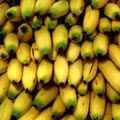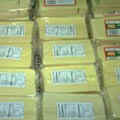|
by Elizabeth Sawin
11 Mar 2002
I have a young friend who, I think, will never eat another banana without thinking a great deal about its history.
On a trip to Belize, Hannah and other home-schooled teenagers saw monkeys, the rainforest, and Mayan villages. But the memory that seems to stand out most vividly is of a banana plantation. The workers at the plantation Hannah visited do not wear protective clothing. When planes fly overhead to spray pesticide, the workers take shelter under the nearest banana leaf.

Going bananas.
"They say the chemicals make their chests hurt," Hannah told me.
Hannah reported that mothers bathe their babies in the tubs in which the bananas are washed, sponging off the babies with the residue of whatever chemicals make their fathers' chests hurt.
At the store where I shop, organic bananas cost 79 cents per pound. Non-organic bananas cost 40 cents per pound. Otherwise, the fruits look identical: bright yellow, cheerful, innocent.
But somewhere between Central America and the U.S. almost the whole story of these bananas has been stripped away. Did the person who picked them earn a fair wage? What chemicals were used? How were they used? All that complexity is reduced to a sticker that says "organic" or "conventional" -- and a price tag.
If Hannah stood in the produce section and told her story, how many people in my town would bring home their first bunch of organic bananas?
None of us can act on information we do not have. The organic label doesn't guarantee that the pickers were paid enough to feed their children. The conventional label doesn't mean that pesticides were used irresponsibly. And 39 cents extra per pound doesn't mean anything except 39 cents extra per pound.
Once I imagine Hannah standing witness in the banana aisle, my imagination takes off. I begin to populate the whole store with providers of missing information.
Who Moved My Cheese?
Beside the cheese case, I place my friends Marsha and Gail, partners in a small cheese-making business. They could explain what you couldn't taste in their cheese: how local farmers are now benefiting from the fair price the cheese-makers pay for milk; how the high pasture where the cows graze turns a brilliant shade of green in early spring; how the milk for this cheese never traveled in a gas-guzzling tractor-trailer truck because the cheese room is next door to the milking parlor.
Their cheese is more expensive than others, but if you could see the farmers, the pasture, and the cleaner air as a part of their product, you'd begin to understand that they are offering a bargain.

The cheese stands alone.
(2002.03.11)
http://www.gristmagazine.com/grist/citiz
en/citizen031102.asp
|
